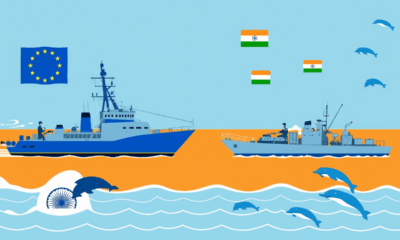Travel
Iceland volcano 2024: Is it safe to travel and is the eruption affecting flights?
A second eruption occurred near the town of Grindavik on Sunday.
A volcano erupted on Sunday on Iceland’s Reykjanes Peninsula for the second time after thousands of small quakes rocked the southwest coast.
The eruption began on 14 January just before 8am local time about 4km northeast of Grindavik, whose residents were evacuated before the event.
Hours later, a second fissure opened near the edge of town and lava crept toward the homes destroying several.
Authorities say the volcanic eruption began to calm down on Tuesday morning although it is still a risky situation as new fissures can emerge at short notice.
Despite lying just 20 km north of the eruption site, Keflavik International Airport – Iceland’s main international airport – remains open and flights are still arriving and departing. The roads around Grindavik are closed, however.
If you are planning on travelling to or from the affected area, here are the full details on advice from European governments and airlines.
How long will Iceland’s volcano eruption last?
The Grindavik community was previously evacuated in November following a series of earthquakes that opened large cracks in the earth between the town and Sýlingarfell, a small mountain to the north.
The volcano eventually erupted on 18 December, and residents were allowed to return to their homes on 22 December.
In the weeks since then, emergency workers have been building defensive walls around Grindavik, but the barriers weren’t complete and lava is moving toward the community, the meteorological office said.
Before last month’s eruption, the Svartsengi volcanic system north of Grindavik had been dormant for around 780 years. The volcano is just a few kilometres west of Fagradalsfjall, which was dormant for 6,000 years before flaring to life in March 2021.
Unlike the previous event, Sunday’s eruption at Svartsengi produced a “very rapid flow” of lava that moved south toward Grindavik, said Kristín Jónsdóttir of the Met Office.
“Luckily, we got some warnings, so we got increased earthquake activity, and this was all communicated towards the civil protection, so the town of Grindavik was evacuated,” she said.
On Monday, scientists said that the eruption appeared to be dying down, but it was too soon to declare the danger over.
Iceland’s president Gudni Th. Johannesson said in a televised address late Sunday that “a daunting period of upheaval has begun on the Reykjanes peninsula” where a long-dormant volcanic system has awakened.
Iceland’s volcano eruption ‘is not a tourist attraction’
Icelandic authorities declared a state of emergency in November after hundreds of small earthquakes shook the Reykjanes Peninsula – the island nation’s most populated region.
“This is not a tourist attraction and you must watch it from a great distance,” Vidir Reynisson, head of Iceland’s Civil Protection and Emergency Management, told national broadcaster RUV.
The eruptive fissure is about 4km long, with the northern end just east of Stóra-Skógfell and the southern end just east of Sundhnúk.
Yet the spectacular natural phenomenon is hard for people to resist. “It’s just [like] something from a movie!” said Robert Donald Forrester III, a tourist from the United States.
For local residents, the emotions are mixed. “The town involved might end up under the lava,” said Ael Kermarec, a French tour guide living in Iceland. “It’s amazing to see but, there’s kind of a bittersweet feeling at the moment.”
Have flights to Iceland been cancelled?
Despite concerns over the impact the eruption will have on travel, nearby Keflavik Airport remains operational. Icelandic airport operator ISAVIA advises passengers to monitor flight information here.
Volcanic eruptions can pose a serious hazard to air travel as ash released into the atmosphere can cause jet engines to fail, damage flight control systems and reduce visibility.
However, Sunday’s eruption on the Reykjanes Peninsula isn’t expected to release large amounts of ash into the air.
There haven’t been cancellations or significant delays at Keflavik International Airport due to the eruption. Icelandair says there has been no impact on its flight schedule, and Play says it does not expect any disruptions to its schedule.
Most airlines have said that they will directly contact customers if this changes. Passengers have been advised to keep a close eye on messages from their airline.
A major eruption in Iceland in April 2010 caused widespread disruption to air travel between Europe and North America. The quarter of a billion cubic metres of volcanic ash it ejected into the air led to more than 100,000 flights being cancelled over an eight-day period.
Though there had been fears of a repeat, Eyjafjallajokull volcano erupted under circumstances that contributed to the immense size of its ash cloud. A glacier on top of it caused meltwater to rapidly cool the lava, creating tiny particles which were launched into the air by the steam produced in the eruption. These were then carried on the wind towards Europe.
The recent eruption took place under very different circumstances lowering the chances of similar flight chaos. In the past three years, three eruptions have taken place on the Reykjanes Peninsula with no impact on air travel.
The European Aviation Safety Agency (EASA) is also better prepared for a major volcanic ash event.
“In the event of an eruption and development of an ash cloud, the agency will work with other aviation actors to assess the impact for aviation and make recommendations accordingly,” a statement on the EASA’s website from November reads.
Various European foreign offices have advised travellers to stay away from Grindavik and respect local restrictions. They direct travellers to the Icelandic Met Office and Safe Travel Iceland for the latest advice.
The UK’s Foreign Office said in updated travel advice for Iceland: “All roads to Grindavík are closed and you should stay away from the area.
“Keflavik International airport is operating as normal, but you should check for latest updates. Reykjavik and the rest of Iceland have not been impacted.
“You should monitor local media for updates and follow the authorities’ advice.”
They have said that the eruption area is closed until further notice and urge people to respect the closure. However, they have not advised against travel to the country altogether.
Visitors are advised to stay away from the area surrounding the eruption, and to follow the directions and guidance of the local authorities.
Countries have not issued a ‘no-go’ travel warning for Iceland meaning that airlines and holiday companies are operating as normal and travellers who cancel their bookings have no automatic right to a refund.
“For those concerned about travel insurance coverage, and whether cancelling a trip is best, we’d advise travellers to exercise common sense and travel wisely,” says Jonathan Frankham, general manager of travel insurance company World Nomads.
“It’s important to note that policies purchased after the earthquakes and consequential volcanic eruption became a ‘known event’ are unlikely to be covered, but we recommend checking your policy wording for exact details.”
He advises tourists to contact their airline or travel provider for assistance and the latest information.
The Blue Lagoon geothermal spa – one of Iceland’s biggest tourist attractions – temporarily closed on 9 November after being hit by earthquakes. It finally reopened on 12 January but has now been forced to shut again until at least 16 January.
“Following an increase in seismic activity detected in the area on the previous night, we took the precautionary measure of evacuating all our operational units. The current eruption site is at a safe distance from Blue Lagoon,” an update on its website reads.
“Consequently, we will remain closed until Tuesday. Further updates and information will be provided here as they become available.
“All guests with bookings during this temporary closure period will be contacted. Guests wishing to modify or cancel their bookings are kindly directed to use the My Booking portal.”
Travel
Wildfire warnings issued in the Canary Islands as millions prepare to holiday there
ADVERTISEMENT
As millions of holidaymakers prepare to head to the Canary Islands this summer, authorities have issued a wildfire pre-alert across the archipelago.
The warning, announced by the General Directorate of Emergencies on Sunday, applies to tourist hotspots El Hierro, La Palma, La Gomera, Tenerife and Gran Canaria.
It comes as the islands enter a high-risk fire period following the wet season, as hot, dry winds known as the ‘calima’ begin blowing in from the Sahara Desert.
Fires are common, but they haven’t slowed tourism
The risk of wildfire is nothing new for the Canary Islands.
The volcanic terrain, Mediterranean climate and fire-adapted vegetation – plants that have evolved to thrive in fire-prone environments – make them susceptible to summer blazes, and scientists say wildfires are part of the archipelago’s ecological rhythm.
Some of the worst occurred in 2023, when forest fires ravaged Tenerife, destroying more than 15,000 hectares of land and forcing 12,000 people to evacuate. The blaze was later found to have been started by arsonists.
This year, officials are urging tourists and locals alike to take extreme caution, warning against launching fireworks near forests and discarding cigarettes on dry ground.
But even as the fire warnings roll in, the Canaries’ appeal shows no signs of slowing down.
In 2024, the islands welcomed nearly 18 million tourists, including a record-breaking 15.5 million international arrivals. Among them, British travellers led the way, recording 6.3 million visits – up 500,000 from 2023.
Concerns about overtourism mount amid record arrivals
While the Canary Islands continue to attract record numbers of tourists, residents are increasingly voicing concerns about overtourism.
In April 2024, tens of thousands of islanders participated in protests, holding signs that read “the Canary Islands have a limit” while rallying against rising housing costs, environmental damage and the strain on public services.
Over Easter this year, about 80,000 hospitality workers in Tenerife, La Palma, La Gomera and El Hierrowalked out in a dispute with unions over pay.
The surge in short-term rentals has been especially contentious. Locals have reported getting priced out of their neighbourhoods as properties are converted into holiday lets, the cost of living soars and wages stagnate.
Despite these concerns, tourism remains a significant part of the Canary Islands’ economy, accounting for approximately 35 per cent of its GDP.
Tenerife still reigns supreme
After welcoming seven million tourists in 2024, Tenerife remains the most visited island.
Its year-round sunshine and wide beaches keep it a firm favourite among families, especially during the UK’s summer school break and throughout the winter months.
As the peak summer season picks up, local tourism boards have made no indication that the fire pre-alerts will disrupt travel plans.
But authorities remain focused on prevention this year.
More than 2,000 firefighters are on standby. Meanwhile, the government has distributed detailed safety advice, urging people to prepare a go-bag, stay informed and follow emergency evacuation or shelter-in-place instructions if fires erupt.
Travel
Violent turbulence hits Ryanair flight in Germany, forcing an emergency landing and injuring 9
By Euronews Travel with AP
Published on
ADVERTISEMENT
Severe storms in southern Germany forced a Ryanair flight to make an emergency landing late Wednesday after violent turbulence injured nine people on board, German police said in a statement Thursday.
The flight, travelling from Berlin to Milan with 179 passengers and six crew members, encountered turbulence so intense around 8:30 pm that the pilot was forced to make an unscheduled landing at Memmingen Airport in Bavaria.
Eight passengers and one crew member were hurt.
Three people were taken to the hospital in Memmingen for treatment; the other injured people were released after receiving outpatient treatment. As a precaution, all passengers were checked for injuries by the emergency services.
Authorities did not permit the plane to continue flying, and the airline arranged bus transport for passengers. Milan is about 380 kilometres south of Memmingen.
More bad weather expected in Germany
Elsewhere in the region, storms damaged several homes in Ulm, Baden-Württmberg, according to the German news agency dpa.
In the Donaustetten district, strong winds tore roofs off multiple row houses, rendering them uninhabitable, though no injuries were reported. Fire officials suspect a small tornado or waterspout caused the damage. The German Weather Service (DWD) is investigating, according to dpa.
Storm-related emergency calls also came from other areas in southern Germany, where damage was mostly limited to fallen trees and flooded basements.
The DWD warned of further storms on Thursday, 5 June, with hail, strong winds, and localised heavy rain expected.
Travel
Hikers ignored warnings before Mount Etna’s latest eruption, Sicilian officials say
Published on
ADVERTISEMENT
Despite warnings to stay away, hikers on Mount Etna were forced to flee this week after Italy’s most active volcano erupted.
Footage from the mountain shared on social media showed tourists scurrying down the slopes as ash rose into the sky. Authorities had issued alerts on Monday morning after signs of increased volcanic activity, but dozens ignored them and climbed toward the summit anyway.
“There was a big explosion and a crater collapsed but luckily it fell into a deserted area,” said Salvo Cocina, head of Sicily’s Civil Protection Department. “It’s very hard to block access [to Mount Etna] – you can’t fence it off.”
No one was injured and the alert level was lowered to the standard ‘yellow’ on Tuesday.
Why is Mount Etna so popular with hikers?
Experiencing a close-up volcanic eruption is a bucket-list event, and Mount Etna offers one of the most accessible opportunities to do it.
At 3,350 metres tall and 35 kilometres wide, the Sicilian giant frequently rumbles to life, offering a front-row seat to nature’s raw power.
Even when it’s active, many trails and paths remain safe to climb.
“[The experience is] a mix of awe and adrenaline,” says mountain guide Saro Trovato, who safely – and legally – climbed Mount Etna when it erupted inFebruary.
“Even from a distance, you can feel the heat radiating from fresh lava flows.”
But above 2,500 metres, hikers are legally required to travel with a qualified mountain guide, who can keep visitors safe as well as informed.
On Tuesday, many hikers were as high as 2,700 metres above sea level.
How to stay safe when visiting Mount Etna
Conditions can change quickly on the mountain.
On Monday, a pyroclastic flow – a fast-moving surge of gas, rock and ash – travelled two kilometres down the mountainside. It didn’t go further than the Valle del Leone, a natural containment area for lava flows, but any changes could have led to catastrophe.
Tourism presents other problems during eruptions, too. In February, Cocina said that tourists parked on narrow roads around Mount Etna had blocked access for emergency vehicles. Firefighters had to be deployed to manage the growing crowds.
This is why the authorities mandate mountain guides such as Trovato, who receive real-time updates from volcanologists and rescue teams and are trained to respond if conditions suddenly change.
“Always check volcanic activity updates from local authorities and respect any access restrictions,” he advises. Especially when the volcano starts to stir.
-
EU & the World4 days ago
Aurora Borealis Forecast: Where & When to See the Northern Lights Tonight
-

 Sports6 days ago
Sports6 days agoChampions League Final 2024-2025: PSG-Inter, official lineups
-

 Sports7 days ago
Sports7 days agoPSG-Inter, Nicolò Barella jokes about Gianluigi Donnarumma
-

 EU & the World5 days ago
EU & the World5 days agoRihanna’s Parents: About Her Late Dad Ronald Fenty & Mom Monica Braithwaite
-

 Sports7 days ago
Sports7 days agoPSG-Inter, Lautaro Martinez unveils recipe for finals
-

 Politics6 days ago
Politics6 days agoEU and India Forge Deeper Maritime Ties with Historic Joint Naval Exercise in the Indian Ocean
-

 Sports5 days ago
Sports5 days agoOfficial: Damien Comolli new general manager of Juventus.
-
Travel7 days ago
France saw record night train passengers in 2024, but can it keep up with booming demand?









